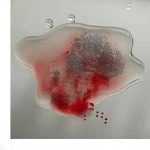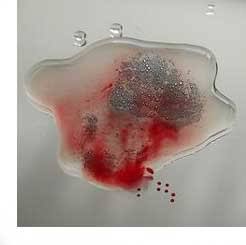An article on the meaning, causes, symptoms, tests and treatment of hematospermia or hemospermia- blood in semen.
This term refers to a condition in which the ejaculated semen is blood-stained; it may be rosy coloured (fresh blood)
or brown to black (old blood). Occasionally hemospermia is associated with haematuria or enlarged epididymis.

It may disappear spontaneously or be recurrent or last for long periods. Most patients are under 40 years. In older patients it may be a symptom of prostate cancer.
Causes of hematospermia
In the majority of cases no cause can be found after thorough urological investigations including cysto-urethroscopy.
The possible causes include:
- infammatory: urethritis, prostatitis, epididymitis, condylomata of urethra and meatus, urinary tract infection, schistosomiasis.
- infections: like chlamydia, cytomegalovirus, gonorrhoea, herpes, trichomoniasis.
- obstruction: urethral stricture, urethral polyps, benign prostatic hypertrophy, calculi (stones) of the prostate, seminal vesicles (SV) and ejaculatory ducts, congenital or post-inflammatory seminal vesicle cysts.
- tumours: prostate, bladder, testis, urethra, seminal vesicles, epididymis.
- mucosal congestion/vascular: prolonged or intense sexual intercourse/masturbation, prostatic varices/telengectasis.
- systemic: leukemia, lymphoma, hypertension, bleeding disorders, chronic liver disease/cirrhosis.
- trauma/iatrogenic: self instrumentation, TRUS biopsy, post-haemorrhoidectomy injection.
- idiopathic or unknown cause.
Symptoms of Hematospermia
Associated symptoms may include:
- Painful urination
- Painful ejaculation
- Penile discharge or symptoms of STDs
- Lower back pain
- Fever
- Tenderness of the testes and/or scrotum
- Swelling of the testes and/or scrotum
- Swelling or tenderness of the groin area.
Management of blood in semen
This includes thorough clinical history and examination to exclude the conditions mentioned above. Urine and blood examinations as for haematuria, VDRL, microscopy, culture and sensitivity of urethral smear after prostatic massage and semen analysis for blood are done.
Transrectal ultrasound helps to detect lesions of the seminal vesicles and prostate (calculi, cysts, tumours, inflammatory changes, varices). Urethrocystoscopy should be performed in all cases to exclude conditions of the urethra, prostate and bladder. PSA and MRI may also be helpful especially for men 40 years and above.
READ ALSO: liver function tests
Treatment of Hematospermia
This consists of advice on sexual habits, tecatment of any underlying cause, (eg. fulguration of granulomata of the urethra and long-term antibiotic therapy in those with urethritis and occasionally urethral dilatation, internal urethrotomy or urethroplasia for urethral stricture) and reassurance of those in whom no cause is found.
Read more on Healthline
Featured Image: Volumaxx





















